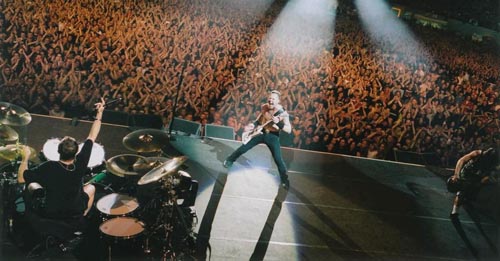Despite growing pains, Korea’s concert scene hits a high note

Metallica performs at Olympic Stadium in southern Seoul in 2006. It was the band’s second concert in Korea; its first concert in 1998 paved the way for other major acts. [JoongAng Ilbo]
Way back in 1998, a local promoter was determined to bring one of the world’s biggest heavy metal bands, Metallica, to South Korea. Unfortunately, the Culture Ministry, whose permission he required, didn’t share his enthusiasm.
“The guy in charge had some guidelines on his desk saying that ‘metal’ and ‘rock’ are absolutely not allowed,” Kim Hong-ki, the head of XS Entertainment, said in a recent interview with Yonhap News Agency. “To overcome his objections, I had to insist that Metallica was not metal music, so I played the opening of ‘One,’ a relatively quiet Metallica song, and persuaded the guy that they were in fact a ballads band. By doing that, I finally got permission.”
Suffice to say, things have changed a bit since then. Over the past few years, a growing number of foreign bands have visited Korea, culminating in a procession of modern and vintage stars playing here this year alone. The past few months have seen Sting, Santana, Iron Maiden perform and, for younger crowds, Ne-Yo and Ke$ha put on raucously received gigs on the Korean Peninsula.
Thankfully for fans in Korea, concert promoters no longer need to plead their case to officious civil servants. But that change in itself isn’t enough to explain the vast growth in Korea’s international concert scene.
On an international level, gigging is increasingly supplanting CD sales as the main source of income for bands. According to the Recording Industry Association of America, the overall global market for recorded music declined by almost a third between 2004 and 2010. In addition, of the world’s 10 top-earning acts in the last decade, seven earned at least twice as much from concert revenues as they did from CD sales.
“It’s a worldwide trend,” said Oh Sung-hoon, CEO of Woodstock Entertainment and a veteran of Korea’s live music scene. “As CD sales drop, people spend more on concerts and it’s happening in Korea, too.”
In Korea, fans have become more worldly in their music tastes, said Euncil Lee from Yescom, the promoter of Korea’s Pentaport Rock Festival. “Many more young people have studied and lived abroad, so they learned a lot about foreign musical tastes.”
Conversely, many of the Koreans who gained exposure to Western music in the 1970s and 1980s are now wealthier and increasingly nostalgic for the music of their youth. “In Korea, major ticket buyers are in their 30s and 40s and financially secure,” said Oh. “That’s why even though the most expensive tickets for the recent Eagles show were about $300, they were completely sold out.”
The increasing success of these large-scale gigs is itself acting as a draw for more stars to come to Korea. But just as important, say industry figures, are Korea’s famously boisterous fans. Muse’s Matt Bellamy and Fran Healy of Travis have both sung the praises of Korean fans. And Kim Yong-il, of promoter Yellow Nine Entertainment, said Eric Clapton proclaimed his February gig in Seoul as the best he had done in two years.
Perhaps however the single biggest reason for the turnaround is the influx of corporate money. Particularly important in this development has been Hyundai Card, whose Super Concert series, run since 2007, has brought in the likes of Billy Joel, Usher and Stevie Wonder.
“Big names typically demand guarantees of $1 million to perform,” said Oh. “Once you include everything else, the budget for a show can easily be $2 million. To make the biggest shows possible, the contributions of corporate sponsors is very important.”
One thing sponsorship hasn’t done, however, is make tickets cheaper. At recent shows by the Eagles, Eric Clapton and Usher, tickets began at 60,000 won ($53), with the best seats at the Eagles gig costing a whopping 330,000 won. So what explains the prices?
“First of all, we have to pay a 24 percent tax [in Korea] on artists’ fees and we have to pay everything in expensive foreign currencies,” said Lee. “Also, we don’t have proper large-sized venues with capacities of 10,000 to 20,000.”
Making matters worse, according to Yim Chong-pil, CEO of CP Entertainment, is the relatively undeveloped condition of Korean promoters in general.
“Concert promoters in Korea lack connections,” said Yim, who last year brought the Pussycat Dolls to Korea. “Since it is really hard to bring artists in if you don’t know anyone from the booking agencies or management, insane amounts of money are offered instead. Then the bidding war starts. Whoever pays most gets the artist.”
Yet for all its challenges, Korea’s allure for big international acts has unquestionably grown to new heights in the last few years. And for Yim, at least, the future looks promising, too. “The only thing we really need to improve on is getting artists for cheaper,” he said. “[But] I think it’s all heading in the right direction.”
Yonhap










with the Korea JoongAng Daily
To write comments, please log in to one of the accounts.
Standards Board Policy (0/250자)